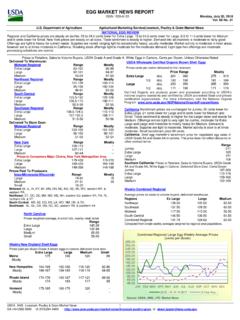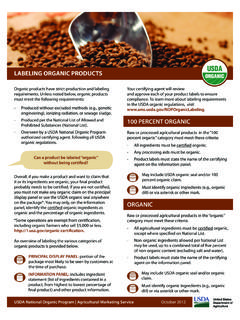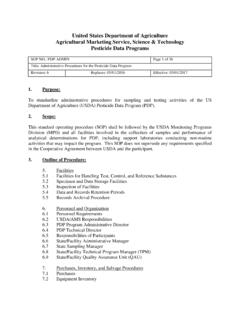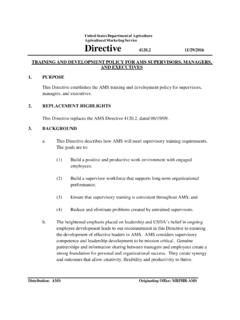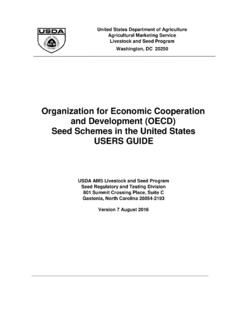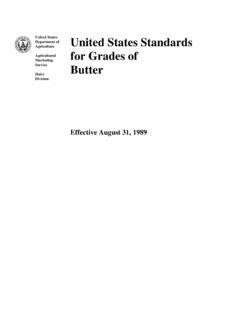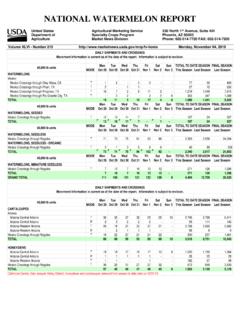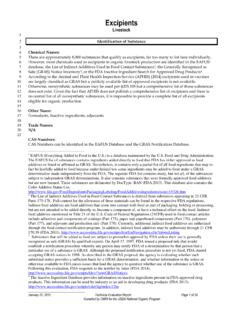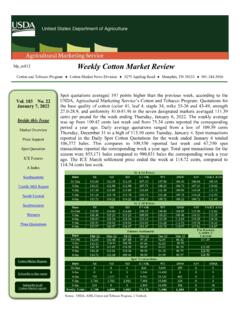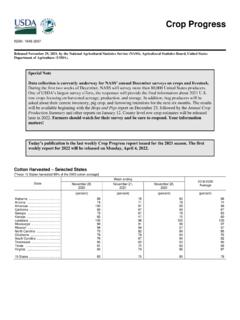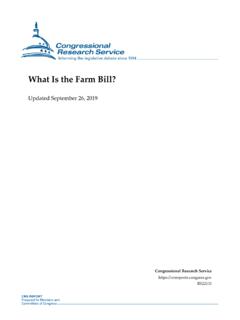Transcription of Hemp Testing Guidelines Issued January 15, 2021
1 Laboratory Testing Guidelines Domestic Hemp Production Program Issued January 15, 2021 Purpose: 1. Standard Testing procedures are specified for samples taken in accordance with the Sampling Procedures for the USDA Hemp Production Program to measure the total delta-9 tetrahydrocannabinol (THC) concentration levels of samples on a dry weight basis. 2. The results are intended to measure the total THC concentration of composite hemp samples collected from a lot of hemp crop acreage designated by a hemp producer and as reported to USDA as required under the USDA Hemp Production Program. The purpose of the measurements is to determine whether the total THC concentration of the tested material is within the acceptable hemp THC level. Scope: 1. Hemp grown under a USDA, State, or Tribal hemp production plan is subject to sampling and compliance Testing for THC concentration. Certain producers, including research institutions and facilities growing immature plants may have different Testing requirements depending on the applicable State or Tribal plan and regulations.
2 2. Tests shall measure the total THC concentration in a sample submitted to a laboratory for analysis. The laboratory will perform chemical analysis on the sample using post- decarboxylation or other similarly reliable methods where the total THC concentration level considers the potential to convert delta-9- tetrahydrocannabinolic acid (THCA) into THC. 3. The total delta-9 tetrahydrocannabinol concentration level shall be determined and reported on a dry weight basis. 4. Laboratories shall calculate and include the Measurement of Uncertainty (MU) when they report THC concentration test results. Measurement of uncertainty is defined as the parameter, associated with the result of a measurement, that characterizes the dispersion of the values that could reasonably be attributed to the particular quantity subject to measurement. USDA does not establish or standardize an upper or lower boundary for general use by laboratories to calculate a measurement of uncertainty.
3 MU is typically not standardized, but rather is controlled using test methods controlled by performance standards ( , AOAC Standard Method Performance Requirements that can be found at ). 5. Hemp Testing laboratories are not required to be ISO accredited, although USDA strongly encourages adherence to the ISO 17025 standard. 6. It is the responsibility of the licensed producer to pay any fees associated with Testing or retesting. Summary of Practice: 1. As required under USDA Hemp Production Program regulations, laboratories that analyze hemp to determine total delta-9 tetrahydrocannabinol THC should meet the following standards: Laboratory quality assurance protocols must ensure the validity and reliability of test results; Analytical method selection, validation, and verification protocols must ensure that the Testing method used is appropriate (fit for purpose) and that the laboratory can successfully perform the Testing ; Protocols for demonstrating Testing validity must ensure consistent, accurate analytical performance; Method performance specifications must ensure analytical tests are sufficiently sensitive for the purposes of the detectability requirements of this part.
4 And Testing protocols must include an effective disposal procedure, in accordance with USDA Guidelines , for non-compliant samples that do not meet the requirements of this part. Measurement of uncertainty (MU) must be estimated and reported with test results. Laboratories shall use appropriate, validated methods and procedures for all Testing activities and evaluate measurement of uncertainty. Sample preparation of pre- or post-harvest sample shall require grinding of the sample to ensure homogeneity of plant material prior to Testing . At a minimum, analytical Testing of samples for total delta-9 tetrahydrocannabinol concentration levels must use post-decarboxylation or other similarly reliable methods approved by the Secretary in writing. The Testing methodology must consider the potential conversion of delta-9 tetrahydrocannabinolic acid (THCA) in hemp into delta-9 tetrahydrocannabinol (THC), and the test result must reflect the total available THC derived from the sum of the THC and THCA content.
5 Current Testing methodologies meeting these requirements include gas chromatography and liquid chromatography. Other methods may be approved if they meet the regulatory requirements. The total delta-9 tetrahydrocannabinol concentration level shall be determined and reported on a dry weight basis. 2. Laboratories should create an internal SOP specific to Testing and retesting hemp and should have the SOP available upon request for inspection. If Sampling Agents are employed, contracted or utilized by a laboratory, the laboratory shall meet all training requirements under the USDA, State, or Tribal hemp production program. 3. After December 31, 2022, laboratories approved for THC Testing must also be registered with DEA to handle controlled substances under the Controlled Substances Act (CSA), 21 CFR part 4. In order to provide flexibility to States and Tribes in administering their own hemp production programs, alternative Testing protocols will be considered, if they are comparable and similarly reliable to the baseline mandated by section 297B(a)(2)(ii) of the Agricultural Marketing Act of 1946 and established under the USDA plan and procedures.
6 Approval for alternative Testing protocols must be requested of USDA in writing and approved in writing by USDA, provided they meet the requirements of this guidance. General Guidelines : General Sample Preparation and Testing Procedures should be conducted as follows: 1. Laboratory receives sample. 2. Dry sample to remove the majority of water. 3. Grind entire sample including leaves, seeds, twigs, and stems. 4. Separate sample into Test and Retain specimens. 5. Package and store the Retain specimen(s) until needed. 6. Analyze the Test specimen. 7. Determine moisture content or dry to a consistent weight. 8. Perform chemical analysis. 9. Calculate total THC concentration on a dry weight basis. Test results should be reported on a dry weight basis. Sample Preparation Guidelines : Samples should be prepared for Testing as follows: 1. Once the composite sample is received by the laboratory, the laboratory should dry the composite sample until brittle in a manner that maintains the THC level of sample.
7 2. If it is not possible to dry the composite sample within 24 hours from the time of sample arrival, the sample should be held in a freezer at approximate -20 C or lower until the sample is dried. 3. After the initial drying step, the laboratory should grind the entire sample including leaves, seeds, twigs, and stems using centrifugal rotor mill or other method as appropriate. All samples received should be ground, regardless of whether they consist of the initial intact material or remediated (shredded or blended) material, as allowed under USDA regulations. 4. The laboratory should create both a Test Specimen and a Retain Specimen for reanalysis and/or confirmation as needed. One sample part should be selected for analysis and labeled ''Test Specimen. The other sample part should be marked "Retain Specimen" and should be packaged and stored in a secured place. The Testing laboratory internal SOP should define the sample size and distribution of Test Specimen and Retain Specimen.
8 5. Samples should be stored in secured locations, in appropriate containers ( , bottles, tubes, vials, etc.). 6. The laboratory should then either determine moisture content or dry the test specimen to a consistent weight. Samples should be dried to a consistent loss (typically 5- 12% moisture content) so that the test can be performed on a dry weight basis, meaning the percentage of THC by weight, after excluding moisture from the sample. The moisture content is expressed as the ratio of the amount of moisture in the sample to the amount of dry solid in the sample. The sample can be dried to a consistent weight to remove all water and then be tested on a dry weight basis. If the sample is not to be extracted immediately after drying, it should be stored in a desiccator. Alternatively, the sample can be analyzed for moisture content and this moisture content can be factored into the total THC result to give a dry weight basis.
9 7. Extraction of the sample should occur as soon as possible from the time of sample arrival. Extracts should be stored in secured locations, in appropriate containers ( , bottles, tubes, vials, etc.). Testing Guidelines : 1. The laboratory will perform chemical analysis on the sample using post- decarboxylation or other similarly reliable methods where the total THC concentration level considers the potential to convert delta-9-tetrahydrocannabinolic acid (THCA) into THC. 2. Testing methodologies meeting these requirements include those using gas chromatography and liquid chromatography. 3. The laboratory will then calculate total THC concentration on a dry weight basis. Testing Methods: 1. The total available THC, derived from the sum of the THC and THCA content, shall be determined and reported on a dry weight basis. 2. Alternative Testing protocols will be considered if they are comparable to the baseline mandated by the 2018 Farm Bill and established under the USDA plan and procedures.
10 Approval to use alternative sampling and Testing procedures must be requested in writing and approved in writing by USDA. 3. Laboratories shall use appropriate, validated methods and procedures for all Testing activities and shall evaluate measurement of uncertainty. 4. Laboratories should meet the AOAC International standard method performance requirements for Quantitation of Cannabinoids in Plant Materials of Hemp (Low THC Varieties Cannabis sp.) (SMPR ) for selecting an appropriate method. 5. The range of estimated uncertainty is reported as a value and is the same unit as the hemp THC threshold ( +/- ), following best practices for significant figures and rounding. 6. There are resources available for defining, guiding, and calculating measurement uncertainty. They include the GUM, ISO, and Eurachem. Once the expanded measurement uncertainty (U) is determined, then the confidence interval can be calculated around a designated threshold.
